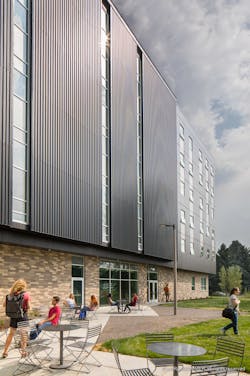The start of the heating season is a vital part of the climate and ecosystems of the northern part of the country.
Many greet this time of year with either dismay at the final end of the summer season while others embrace the opportunities available in the winter months. In terms of the operation of buildings, it represents a shift in the mechanical systems that operate the HVAC units as buildings shift into heating mode. This means typically burning substantial quantities of natural gas (or heating oil) to maintain the indoor set point.
The amount of energy used for indoor heating is driven largely by the size and ventilation requirements of a given building. For commercial, industrial, municipal and multi-residential buildings the amount of energy used for heating can be very significant and is therefore one of the main contributors to carbon emissions from the building sector. It is essential to consider how can the demand for natural gas heating be reduced. The main options are fuel switching to heat pumps or direct demand reduction from technologies such as solar air heating.
Demand reduction with solar air heating is straightforward because it can be retrofitted into most buildings with traditional rooftop HVAC units. Solar air heating systems heat the incoming ventilation air before it reaches the fresh air side of the HVAC or the HRV/ERV unit, minimizing building fuel consumption throughout the heating season.
The technology uses an all-metal perforated exterior panel; when the sun’s radiation strikes the surface of the solar facade, fresh, solar-heated air accumulates on the surface of the collector. This air is heated – up to 75°F above ambient temperatures on a sunny day – and then drawn in through the perforations under negative pressure where it travels to the existing HVAC unit’s fresh air intake via mechanical ducting.
In the summer, when solar-heated air is not desired, the system is bypassed and the HVAC system will draw direct from ambient.
Stacy Watters is an engineer for the State of South Dakota and has extensive experience with solar air heating systems as a demand reduction strategy. Speaking on her experiences over the last several years she says, "South Dakota has been extremely pleased with the six solar air heating systems we have installed across the state. We have recently switched into heating mode and are enjoying the benefits of free daytime heating at these buildings. During the winter months, these six locations utilize the SolarWall system as the main heating source for the overhead bays in lieu of conventional natural gas heaters. This has helped us reduce our energy consumption, reduce our utility bills, and reduce our carbon footprint. These solar systems are also made of metal and they have a longer life span than natural gas heaters, which in turn will help reduce waste going to the landfills."
At Montana State University, solar air heating systems are operational on most of the new campus buildings where they complement the energy objectives of the school. Bozeman, MT, is a cold climate city and heating is the largest source of building energy, so it made sense to focus on solar heating. The fact that solar air heating systems are made of metal was also a major benefit in terms of creating the architectural strategies for different buildings.
At the university, Gallatin College HVAC program students take a class titled Energy-Efficient Technologies and Renewable Energy. Instructor Susan Bilo uses the solar air heating technology to achieve multiple learning objectives and help students discover why solar heating works well in Montana’s cold, sunny climate.
“I use the solar portion of the electromagnetic spectrum and heat transfer and movement principles to explain how the technology works. My students are impressed that there is a system that does double duty by pre-heating ventilation air using the sun’s free energy. After covering the basics in the classroom, students take a fieldtrip to 'find' SolarWall systems on multiple Montana State University campus buildings. Students learn about the campus district energy system and how the solar heating systems reduce the amount of fossil fuel combusted to heat air.”
So now, as different states transition into some type of heating mode in the weeks ahead, it is logical for them to consider different heating options along the renewable energy spectrum. These recent experiences in Montana and South Dakota offer two good examples of how solar heating can deliver benefits across different building types and still decrease carbon emissions.
##########
Based in Toronto, the author is a Vice President and Principal at Conserval Engineering Inc., where she has worked since 2009. Focused on the commercial and industrial sectors, Conserval is the creator of the SolarWall technology. For more, go to www.solarwall.com.










